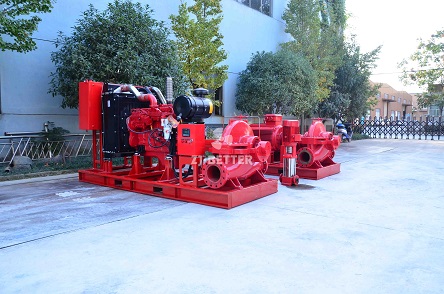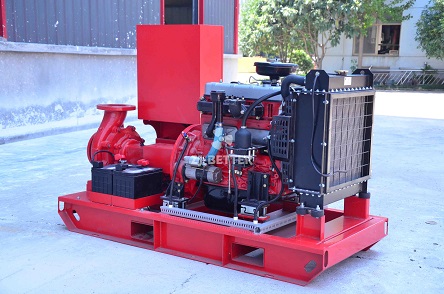How do fire pumps work?
Aug 01, 2022
Share:
Previous to installation, sprinkler systems are hydraulically calculated to determine the permissible water inflow rate to give fire control previous to the appearance of the fire squad. Once it has been determined that there's an external power input shy of the system to operate effectively, the fire pump is installed. The fire pump is actuated when the pressure in the sprinkler system drops below a certain threshold due to the operation of the sprinkler heads. The fire pump draws fresh water from an external hydraulic or point water storehouse tank to maintain the needed operating pressure in the sprinkler system. Fire pumps are frequently needed in high- rise structures and large structures because of the size and pressure loss of pipeline systems.

Fire pumps are one of numerous clear exemplifications of water pump operations. Fire pumps can be used in pastoral areas where the homeowner may have further of a rush to extinguish a fire than if the nearest fire station crew was delayed in getting to the scene. In this way, these pumps save lives and property. Fire pumps can be demanded anywhere in a fairly large area, so they need to be mobile and fluently transmittable. For this reason, fire pumps are generally gasoline water pumps. Gasoline water pumps run on gasoline, not electricity or diesel energy, which are generally used in the other two types of water pumps. Water is drawn by the pump from natural bodies of water or artificial water sources, similar as tanks or ponds, and delivered to the fire that needs to be extinguished.
Where fire pumps aren't used in this way, they're used as part of the water force of a fire sprinkler system. These fire pumps can be diesel, electric or gasoline water pumps. The pump bay can be connected to underground mains water or to a static water force, similar as any of the types mentioned over. Pumps give advanced bay water pressure than sprinkler boilers and standpipes with socks. Fire pumps are generally tested by a third- party listing association for compliance with norms. This ensures that the outfit is officially functional and that hazards are minimized.

In some request designs, fire pumps are powered only by the electric grid. This is because a fire or explosion can take out the electrical grid, which can also beget the sprinkler system to shut down. In this case, a gasoline water pump can be used or the pump can be electrically driven through a specified transfer switch or inflammatory power creator.
Fire pumps are touched off when the sprinkler system detects a drop in pressure below a specified threshold, which occurs when sprinklers discharge heat. In other fire sprinkler systems, a roll of fire socks or other apparel is opened to depressurize the main line.
.jpg)
Fire pumps are used when external water systems can not give sufficient pressure for the hydraulic conditions of the sprinkler system. This situation is frequently set up in structures several stories high or with large internal volumes, similar as high- rise structures and storages.
There are numerous types of fire pumps, including perpendicular split case, end suction, perpendicular split case, perpendicular turbine, and perpendicular inline.

Fire pumps are one of numerous clear exemplifications of water pump operations. Fire pumps can be used in pastoral areas where the homeowner may have further of a rush to extinguish a fire than if the nearest fire station crew was delayed in getting to the scene. In this way, these pumps save lives and property. Fire pumps can be demanded anywhere in a fairly large area, so they need to be mobile and fluently transmittable. For this reason, fire pumps are generally gasoline water pumps. Gasoline water pumps run on gasoline, not electricity or diesel energy, which are generally used in the other two types of water pumps. Water is drawn by the pump from natural bodies of water or artificial water sources, similar as tanks or ponds, and delivered to the fire that needs to be extinguished.
Where fire pumps aren't used in this way, they're used as part of the water force of a fire sprinkler system. These fire pumps can be diesel, electric or gasoline water pumps. The pump bay can be connected to underground mains water or to a static water force, similar as any of the types mentioned over. Pumps give advanced bay water pressure than sprinkler boilers and standpipes with socks. Fire pumps are generally tested by a third- party listing association for compliance with norms. This ensures that the outfit is officially functional and that hazards are minimized.

In some request designs, fire pumps are powered only by the electric grid. This is because a fire or explosion can take out the electrical grid, which can also beget the sprinkler system to shut down. In this case, a gasoline water pump can be used or the pump can be electrically driven through a specified transfer switch or inflammatory power creator.
Fire pumps are touched off when the sprinkler system detects a drop in pressure below a specified threshold, which occurs when sprinklers discharge heat. In other fire sprinkler systems, a roll of fire socks or other apparel is opened to depressurize the main line.
.jpg)
Fire pumps are used when external water systems can not give sufficient pressure for the hydraulic conditions of the sprinkler system. This situation is frequently set up in structures several stories high or with large internal volumes, similar as high- rise structures and storages.
There are numerous types of fire pumps, including perpendicular split case, end suction, perpendicular split case, perpendicular turbine, and perpendicular inline.

.png)
.png)

.png)


